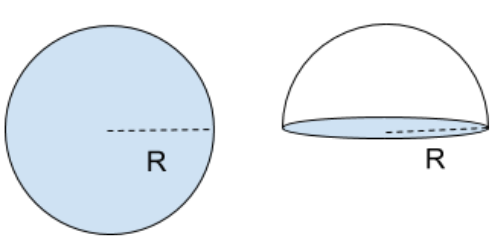
The increase in the total surface area of a sphere of radius R when it is cut to make two hemispheres of same radius will be equal to-
$A.\;5\pi {R^2}$
${\text{B}}.\;4\pi {R^2}$
${\text{C}}.\;3\pi {R^2}$
${\text{D}}.\;2\pi {R^2}$
Answer
594k+ views
Hint: The surface area of a sphere is given by the formula $4\pi {R^2}$, the curved surface area of the hemisphere is half the value. After calculating the surface areas, we will find their difference to find the answer.
Complete step-by-step solution -

We know that the total surface area of a sphere is given by $4\pi {R^2}$.
The curved surface area of the hemisphere is $2\pi {R^2}$.
The total surface area of the hemisphere is the sum of the curved surface area and the flat surface of radius R. So the total surface area is-
$\begin{gathered}
= 2\pi {R^2} + \pi {R^2} \\
= 3\pi {R^2} \\
\end{gathered} $
The total surface area of two such hemispheres is $6\pi {R^2}$.
The increase in the total surface area is $6\pi {R^2}$ - $4\pi {R^2}$ = $2\pi {R^2}$
Hence, the correct option is D.
Note: Students often forget to add the surface area of the circle, that is the flat surface. As a result, they get the incorrect answer. We should know the difference between the total surface area and the curved surface area.
Complete step-by-step solution -

We know that the total surface area of a sphere is given by $4\pi {R^2}$.
The curved surface area of the hemisphere is $2\pi {R^2}$.
The total surface area of the hemisphere is the sum of the curved surface area and the flat surface of radius R. So the total surface area is-
$\begin{gathered}
= 2\pi {R^2} + \pi {R^2} \\
= 3\pi {R^2} \\
\end{gathered} $
The total surface area of two such hemispheres is $6\pi {R^2}$.
The increase in the total surface area is $6\pi {R^2}$ - $4\pi {R^2}$ = $2\pi {R^2}$
Hence, the correct option is D.
Note: Students often forget to add the surface area of the circle, that is the flat surface. As a result, they get the incorrect answer. We should know the difference between the total surface area and the curved surface area.
Recently Updated Pages
Master Class 10 General Knowledge: Engaging Questions & Answers for Success

Master Class 10 Computer Science: Engaging Questions & Answers for Success

Master Class 10 English: Engaging Questions & Answers for Success

Master Class 10 Social Science: Engaging Questions & Answers for Success

Master Class 10 Maths: Engaging Questions & Answers for Success

Master Class 10 Science: Engaging Questions & Answers for Success

Trending doubts
The shortest day of the year in India

Why is there a time difference of about 5 hours between class 10 social science CBSE

Write a letter to the principal requesting him to grant class 10 english CBSE

What is the median of the first 10 natural numbers class 10 maths CBSE

The Equation xxx + 2 is Satisfied when x is Equal to Class 10 Maths

State and prove converse of BPT Basic Proportionality class 10 maths CBSE




